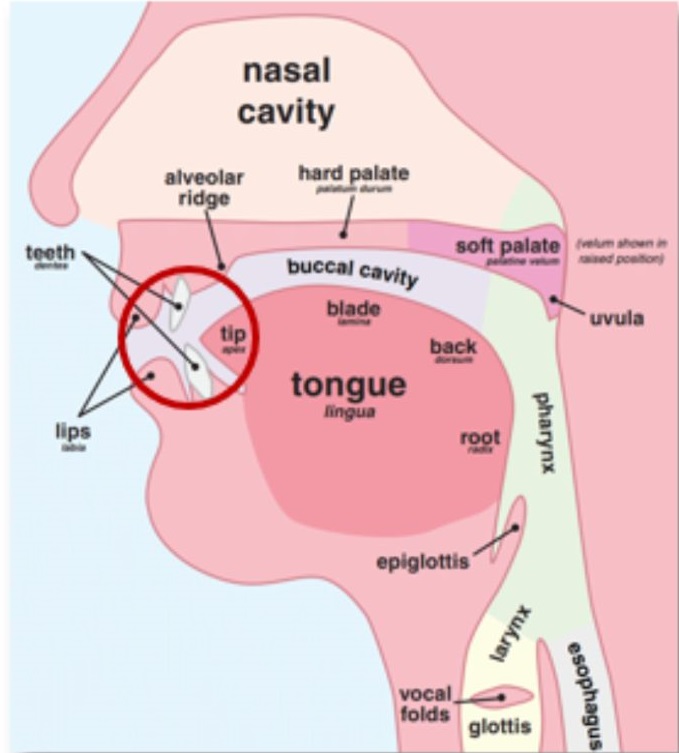There are some easy tips and techniques through which pronouncing Arabic letters becomes an easy task to do. In this article, will do the same. At the end of this article, you will be able to pronounce the letter س {sīn} easily with the different harakat (Vowel movements):
Fat̊ḥa فَتْحَة َ
Kasrah كسرة ِ
Dammah ضمة ُ
Jazm / Sokoun جزم ْ
Shadda شدة ّ
Here it is important to understand some parts of the mouth through which we will be pronouncing the letter س {sīn}
- ثنايا عليا (tẖanāyā ʿul̊yā): The front four teeth are called ثنايا (tẖanāyā), the two upper teeth are calledثنايا عليا (tẖanāyā ʿul̊yā).
- ثنايا سفلى (tẖanāyā suf̊la): The front lower two teeth are called Sanaya Sufla.
- The tip of our tongue.

Now, let’s pronounce س {sīn}: Touch the tip of your tongue at the edge of the upper two teeth (tẖanāyā ʿul̊yā) along with the edge of the lower front teeth (tẖanāyā suf̊la) and say س {sīn}. Practice this sound again and again.
Let’s practice س {sīn} with vowel movements.
Fat̊ḥa فتحة: It is a small diagonal line on the top of the letter and sounds as ‘AA’. For example:
سَ = SA, Read as; S fatah SA
Kasrah كسرة: It is a small diagonal line below a letter and sounds like ‘EE’. For example:
سِ = See, Read as; S kasrah See
Dammah ضمة: It is a small comma like symbol on the top of the letter and sounds like ‘UU’. For example:
سُ = SU, Read as; S dammah SU
Jazm / Sokoun جزم: Jazm is also called sokoun, a letter with Jazm is called Sakin. It is a small round symbol above the letter. It means that this letter is joint with the letter before it. For example:
سْ = S sakin, أَسْ = Alif fatha + S sakin = ạå̉s̊
Shadda شدة: When a letter having symbol ّ , it is called Mushadad. It is pronounced by saying the letter twice with one movement of the tongue. It is read by joining two letters and also read with harakat.
أَسَّ= ảssã أَسِّ = ảssĩ – أَسُّ = å̉ssũ
To learn more about the Arabic Harakat, here you can find the easiest way to practice Tashkeel:
Now, practice the letter س {sīn} by saying these words:
سَلْطَعُون (sal̊ṭaʿūn – Crab)
سَلَطَةٌ (salaṭaa – Salad)
سُمَّانْ (sumãạn̊ – Quail)
سِحَاب (siḥāb – Clouds)
سَمَكَةٌ (samaka – Fish)
سُكَّرٌ (sukãr – Sugar)
Listen to some Arabic Words starting with the letter س {sīn}
Here, you can learn how to write the letter س {sīn}
The Difference between the sounds س {sīn}, ث {tẖāʾ} and ص {ṣād}:
- The sound of letters ث {tẖāʾ}, س {sīn} and ص {ṣād} are apparently the same as ‘S’, but there’s a difference between the pronunciation of all three. And here’s how:
ث {tẖāʾ} is pronounced by touching the edge of the tongue to ثنايا عليا (tẖanāyā ʿul̊yā): (upper front teeth) while س {sīn} and ص {ṣād} are pronounced by touching the edge of the tongue to ثنايا سفلى (tẖanāyā suf̊la) (lower front teeth) along with (tẖanāyā ʿul̊yā). - The ص {ṣād} sound is thicker than the other two.
Listen carefully to the following sounds in order to practice the difference between the sounds س {sīn}, ث {tẖāʾ} and ص {ṣād}:
For more explanation about how Arabic letters are written, please check out this article:
How Arabic letters are written in their different positions?
You may also need to check out this article:
What is the difference between س {sīn} and ص {ṣād} in Arabic?
For more practice about the letter س {sīn}, you can watch this video tutorial:
Timestamp:
00:00 How to write the Arabic letter س {sīn}
00:50 The different forms of writing the letter س {sīn} according to its positions.
00:30 س vs ص: What is the difference between the Arabic letter س {sīn}, and the Arabic letter ص {ṣād}?
2:10 How to pronounce the Arabic letter س {sīn} with harakat (Arabic vowles)? Shaddah, damma, kassrah, tanween, sukoun, mad.
3:10 How to pronounce the Arabic letter س {sīn} with harakat (Arabic vowles)? Shaddah, damma, kassrah, tanween, sukoun, mad.
3:40 Let’s practice how to differentiate between the letter س {sīn}, and the Arabic letter ص {ṣād}.
Practice makes perfect. Hence, keep practicing and keep improving!










